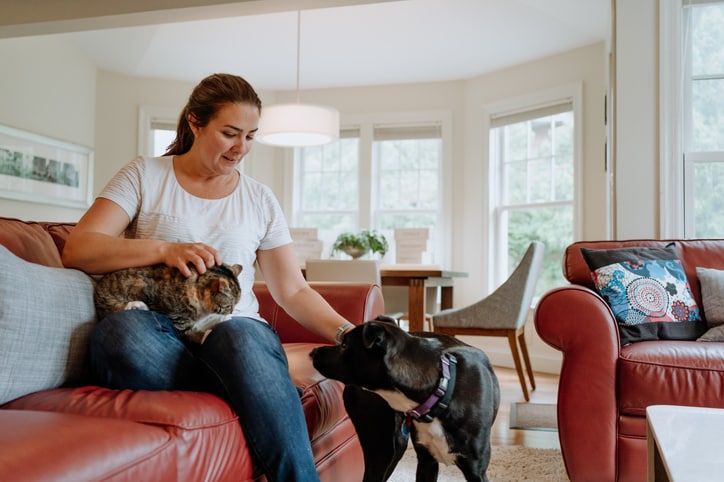Just the thought of doughnuts makes the beloved TV character Homer Simpson drool. And your dog likely drools when he’s presented with his favorite foods, too. But there are a variety of other reasons that your pet may release this slobbery substance. If you feel the need to mop your floors on a regular basis, it’s time for you to find out if this behavior is normal. Here’s an overview on dog drooling!
Why Do Dogs Drool?
If you’re a dog owner, you might need to get used to a certain level of drool, as it constitutes normal behavior for many canine companions. Drool is just saliva, after all. Like people, dogs need saliva to help them eat and digest.
“Dogs drool for two reasons: normal drool and ‘I am ill’ drool,” says Dr. Denise Petryk, the director of veterinary services at Trupanion, a pet-insurance firm. According to Dr. Petryk, the amount of drool that is considered normal depends on the shape of your dog’s mouth, his breed and whether or not he has the ability to swallow his saliva as fast as he produces it.
But it’s important to remember that your dog may drool more than normal as a result of “excessive salivation related to illness,” says Dr. Petryk. This behavior may be related to a variety of medical conditions, such as dental disease, rotten teeth, an abscessed tooth, a salivary gland tumor, infection, inflammation, stomach disorder, nausea, or a brain tumor, she says.
What Constitutes a Normal Amount of Drool?
Do you get covered with water if you don’t get out of the way when your dog shakes her body after a bath? Well, if you have one of the droolier breeds, you may get covered with saliva if your slobbery friend decides to rock his head back and forth. Yuck! According to Dr. Petryk, this kind of excess drool is common among dogs who have “saggy lips.” If your dog doesn’t boast big jowls and has tight lips, you shouldn’t find any drool or saliva dripping from his mouth. Dogs that fall into this category “should be able to swallow their saliva as fast as it is made,” says Dr. Petryk.
However, there are some exceptions to this rule. For instance, all dogs may drool when they anticipate a yummy meal or snack, she says. Non-droolers could also let some saliva escape when they are excited, playing hard, or panting once they come back from their walk.
When Should You Be Concerned About Dog Drooling?
The amount of drool that may be considered alarming is different in saggy-mouthed dogs than tight-lipped dogs. Overall, it’s important to remember that “any amount of saliva that is more than normal for your dog is a cause for concern,” says Dr. Amanda Landis-Hanna, the director of veterinary medicine at i4C Innovations in Chantilly, Virginia. If your dog has jowls, you probably always need to have hand towels ready to wipe up any excess saliva. In this situation, excessive drooling should not be cause for concern.
On the other hand, you should be concerned about a non-drooler who “suddenly starts to drool excessively with no tasty treats or active play in sight,” says Dr. Petryk. If you find that this applies to your pet’s case, you should take him to the vet to get checked out, she says.
When thinking about your saggy-mouthed dog’s normal drooling behavior, it’s important to remember that his mouth can get even saggier as he ages. And dogs don’t normally get face lifts, even if they do live in Beverly Hills. “As gravity drags those lips down, it is easier for the drool to escape,” says Dr. Petryk. But an abnormal amount of drool is not the only potential cause for concern. You should also rush your dog to the vet if his drool is “smelly, cloudy or bloody,” says Dr. Petryk.
Which Breeds Drool the Most?
Some of the most lovable gentle giants are also big-time slobberhounds. If you own a mastiff, bloodhound, boxer, bulldog, Newfoundland, bullmastiff, Saint Bernard, or Great Dane, you are guaranteed to get slimed at one point or another. But “highly food-motivated breeds often drool as well,” says Dr. Landis-Hanna. This may include Labrador retrievers, golden retrievers, and labradoodles.
If the thought of drool has you daydreaming about switching to cat ownership, you should consider one of the many breeds that do not often engage in this behavior. “Some breeds drool less, such as springer spaniels, French bulldogs and standard poodles,” says Dr. Landis-Hanna. “But each dog is different!”
Also check out Why Does My Dog Lick Me so Much?
Laura Agadoni is a pet writer and pet owner whose articles appear in various publications such as The Daily Puppy, Pets on Mom.me, The Nest, Tom’s of Maine, The Penny Hoarder and Trulia.
*This article is for general informational purposes only. It is not intended nor implied to be providing medical advice and is not a substitute for such advice. The reader should always consult a health care provider concerning any medical condition or treatment plan. Neither Care.com nor the author assumes any responsibility or liability with respect to use of any information contained herein.




